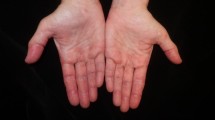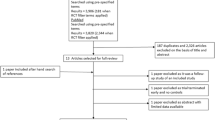Abstract
Dermatomyositis and polymyositis are classified as members of idiopathic inflammatory myopathies. It has recently become evident that the pathogenesis of the muscle disease for these two entities is likely not the same. Despite this observation, therapies directed at the muscle disease are similar, although therapy for the skin differs slightly. Corticosteroids remain the initial approach to management. The systemic dose of corticosteroids needed to control the disease, particularly the skin disease, is quite high; therefore, most authorities add a corticosteroid-sparing agent early. Some patients will naturally “burn out” the inflammatory component of their disease, but many have continuing disease activity that requires maintenance therapy. In this article, we briefly define the disease state of dermatomyositis, discuss the associated systemic manifestations, and update the selection and evaluation of immunomodulatory, corticosteroid-sparing agents.
Similar content being viewed by others
References and Recommended Reading
Callen JP, Wortmann RL: Dermatomyositis. Clin Dermatol 2006, 24:363–373.
Callen JP: Dermatomyositis. Lancet 2000, 355:53–57.
Bohan A, Peter JB: Polymyositis and dermatomyositis (first of two parts). N Engl J Med 1975, 292:344–347.
Bohan A, Peter JB: Polymyositis and dermatomyositis (second of two parts). N Engl J Med 1975, 292:403–407.
Gerami P, Schope JM, McDonald L, et al.: A systematic review of adult-onset clinically amyopathic dermatomyositis (dermatomyositis siné myositis): a missing link within the spectrum of the idiopathic inflammatory myopathies. J Am Acad Dermatol 2006, 54:597–613.
Pachman LM, Abbott K, Sinacore JM, et al.: Duration of illness is an important variable for untreated children with juvenile dermatomyositis. J Pediatr 2006, 148:247–253.
Huber AM, Dugan EM, Lachenbruch PA, et al.: Preliminary validation and clinical meaning of the cutaneous assessment tool in juvenile dermatomyositis. Arthritis Rheum 2008, 59:214–221.
Carroll CL, Lang W, Snively B, et al.: Development and validation of the Dermatomyositis Skin Severity Index. Br J Dermatol 2008, 158:345–350.
Gaines E, Werth VP: Development of outcome measures for autoimmune dermatoses. Arch Dermatol Res 2008, 300:3–9.
Isenberg DA, Allen E, Farrell V et al.: International consensus outcome measures for patients with idiopathic inflammatory myopathies. Development and initial validation of myositis activity and damage indices in patients with adult onset disease. Rheumatology (Oxford) 2004, 43:49–54.
Cordiero AC, Isenberg DA: Treatment of inflammatory myopathies. Postgrad Med J 2006, 82:417–424.
Fiorentino DF, Callen JP: Dermatomyositis. In Evidence Based Dermatology. Edited by Williams H, Bigby M, Diepgen T, et al. London: BMJ Press; 2008.
Winkelmann RK, Mulder DW, Lambert EH, et al.: Course of dermatomyositis-polymyositis: comparison of untreated and cortisone-treated patients. Mayo Clin Proc 1968, 43:545–556.
Klein-Gitelman MS, Waters T, Pachman LM: The economic impact of intermittent high-dose intravenous versus oral corticosteroid treatment of juvenile dermatomyositis. Arthritis Care Res 2000, 13:360–368.
Bohan A, Peter JB, Bowman RL, Pearson CM: Computer-assisted analysis of 153 patients with polymyositis and dermatomyositis. Medicine (Baltimore) 1977, 56:255–286.
Nzeusseu A, Brion F, Lefèbvre C, et al.: Functional outcome of myositis patients: can a low-dose glucocorticoid regimen achieve good functional results? Clin Exp Rheumatol 1999, 17:441–446.
Dawkins MA, Jorizzo JL, Walker FO, et al.: Dermatomyositis: a dermatology-based case series. J Am Acad Dermatol, 1998, 38:397–404.
Bunch TW, Worthington JS, Combs JJ, et al.: Azathioprine with prednisone for polymyositis. A controlled, clinical trial. Ann Intern Med 1980, 92:365–369.
Miller J, Walsh Y, Saminaden S, et al.: Randomised double blind controlled trial of methotrexate and steroids compared with azathioprine and steroids in the treatment of idiopathic inflammatory myopathy. J Neurological Sci 2002, 199(Suppl 1):S53.
Ramanan, AV, Campbell-Webster N, Ota S, et al.: The effectiveness of treating juvenile dermatomyositis with methotrexate and aggressively tapered corticosteroids. Arthritis Rheum 2005, 52:3570–3578.
Villalba L, Adams EM, Sherman JB, et al.: Treatment of refractory myositis: a randomized crossover study of two new cytotoxic regimens. Arthritis Rheum 1998, 41:392–399.
Kamel OW, van de Rijn M, Weiss LM, et al.: Brief report: reversible lymphomas associated with Epstein-Barr virus occurring during methotrexate therapy for rheumatoid arthritis and dermatomyositis. N Engl J Med 1993, 328:1317–1321.
Waldman MA, Callen JP: Self-resolution of Epstein-Barr virus-associated B-cell lymphoma in a patient with dermatomyositis following withdrawal of mycophenolate mofetil and methotrexate. J Am Acad Dermatol 2004, 51(2 Suppl):S124–S130.
Bunch TW: Prednisone and azathioprine for polymyositis. Arthritis Rheum 1981, 24:45–48.
Gelber AC, Nousari HC, Wigley FM: Mycophenolate mofetil in the treatment of severe skin manifestations of dermatomyositis: a series of 4 cases. J Rheumatol 2000, 27:1542–1545.
Tausche AK, Meurer M: Mycophenolate mofetil for dermatomyositis. Dermatology 2001, 202:341–343.
Majithia V, Harisdangkul V: Mycophenolate mofetil (Cell-Cept): an alternative therapy for autoimmune inflammatory myopathy. Rheumatology (Oxford) 2005, 44:386–389.
Edge JC, Oultand JD, Dempsey JR, Callen JP: Mycophenolate mofetil as an effective corticosteroid-sparing therapy for recalcitrant dermatomyositis. Arch Dermatol 2006, 142:65–69.
Rowin J, Amato AA, Deisher N, et al.: Mycophenolate mofetil in dermatomyositis: is it safe? Neurology 2006, 66:1245–1247.
Vencovsky J, Jarosová K, Machácek S, et al.: Cyclosporine A versus methotrexate in the treatment of polymyositis and dermatomyositis. Scand J Rheumatol 2000, 29:95–102.
Wilkes MR, Sereika SM, Fertig N, et al.: Treatment of antisynthetase-associated interstitial lung disease with tacrolimus. Arthritis Rheum 2005, 52:2439–2446.
Sinoway PA, Callen JP: Chlorambucil. An effective corticosteroid-sparing agent for patients with recalcitrant dermatomyositis. Arthritis Rheum 1993, 36:319–324.
Adams EM, Pucino F, Yarboro C, et al.: A pilot study: use of fludarabine for refractory dermatomyositis and polymyositis, and examination of endpoint measures. J Rheumatol 1999, 26:352–360.
Riley P, Maillard SM, Wedderburn LR, et al.: Intravenous cyclophosphamide pulse therapy in juvenile dermatomyositis. A review of efficacy and safety. Rheumatology (Oxford) 2004, 43:491–496.
Dalakas MC, Illa I, Dambrosia JM, et al.: A controlled trial of high-dose intravenous immune globulin infusions as treatment for dermatomyositis. N Engl J Med 1993, 329:1993–2000.
Gottfried I., Seeber A, Anegg B, et al.: High dose intravenous immunoglobulin (IVIG) in dermatomyositis: clinical responses and effect on sIL-2R levels. Eur J Dermatol 2000, 10:29–35.
Levine TD: Rituximab in the treatment of dermatomyositis: an open-label pilot study. Arthritis Rheum 2005, 52:601–607.
Noss EH, Hausner-Sypek DL, Weinblatt ME: Rituximab as therapy for refractory polymyositis and dermatomyositis. J Rheumatol 2006, 33:1021–1026.
Chung L, Genovese MC, Fiorentino DF: A pilot trial of rituximab in the treatment of patients with dermatomyositis. Arch Dermatol 2007, 143:763–767.
Cooper MA, Willingham DL, Brown DE, et al.: Rituximab for the treatment of juvenile dermatomyositis: a report of four pediatric patients. Arthritis Rheum 2007, 56:3107–3111.
Dinh HV, McCormack C, Hall S, Prince HM: Rituximab for the treatment of the skin manifestations of dermatomyositis: a report of 3 cases. J Am Acad Dermatol 2007, 56:148–153.
Efthimiou P, Schwartzman S, Kagen LJ: Possible role for tumour necrosis factor inhibitors in the treatment of resistant dermatomyositis and polymyositis: a retrospective study of eight patients. Ann Rheum Dis 2006, 65:1233–1236.
Dold S, Justiniano ME, Marquez J, Espinoza LR: Treatment of early and refractory dermatomyositis with infliximab: a report of two cases. Clin Rheumatol 2007, 26:1186–1188.
Iannone F, Scioscia C, Falappone PC, et al.: Use of etanercept in the treatment of dermatomyositis: a case series. J Rheumatol 2006, 33:1802–1804.
Hengstman GJ, De Bleecker JL, Feist E, et al.: Open-label trial of anti-TNF-alpha in dermato-and polymyositis treated concomitantly with methotrexate. Eur Neurol 2008, 59:159–163.
Quain RD, Werth VP: Management of cutaneous dermatomyositis: current therapeutic options. Am J Clin Dermatol 2006, 7:341–351.
Hollar CB, Jorizzo JL: Topical tacrolimus 0.1% ointment for refractory skin disease in dermatomyositis: a pilot study. J Dermatolog Treat 2004, 15:35–39.
Woo TY, Callen JP, Voorhees JJ, et al.: Cutaneous lesions of dermatomyositis are improved by hydroxychloroquine. J Am Acad Dermatol 1984, 10:592–600.
Ang GC, Werth VP: Combination antimalarials in the treatment of cutaneous dermatomyositis: a retrospective study. Arch Dermatol 2005, 141:855–859.
Zieglschmid-Adams ME, Pandya AG, Cohen SB, Sontheimer RD: Treatment of dermatomyositis with methotrexate. J Am Acad Dermatol 1995, 32(5 Pt 1):754–757.
Kasteler JS, Callen JP: Low-dose methotrexate administered weekly is an effective corticosteroid-sparing agent for the treatment of the cutaneous manifestations of dermatomyositis. J Am Acad Dermatol 1997, 36:67–71.
Boswell JS, Costner M: Leflunomide as adjuvant treatment of dermatomyositis. J Am Acad Dermatol 2008, 58:403–406.
Huber A, Gaffal E, Bieber T, et al.: Treatment of recalcitrant dermatomyositis with efalizumab. Acta Derm Venereol 2006, 86:254–255.
Sereda D, Werth VP: Improvement in dermatomyositis rash associated with the use of antiestrogen medication. Arch Dermatol 2006, 142:70–72.
Pelle MT, Callen JP: Adverse cutaneous reactions to hydroxychloroquine are more common in patients with dermatomyositis than in patients with cutaneous lupus erythematosus. Arch Dermatol 2002, 138:1231–1233; discussion 1233.
Chung YL, Alexanderson H, Pipitone N, et al.: Creatine supplements in patients with idiopathic inflammatory myopathies who are clinically weak after conventional pharmacologic treatment: six-month, double-blind, randomized, placebo-controlled trial. Arthritis Rheum 2007, 57:694–702.
Author information
Authors and Affiliations
Corresponding author
Rights and permissions
About this article
Cite this article
Callen, J.P. Immunomodulatory treatment for dermatomyositis. Curr Allergy Asthma Rep 8, 348–353 (2008). https://doi.org/10.1007/s11882-008-0055-1
Published:
Issue Date:
DOI: https://doi.org/10.1007/s11882-008-0055-1




